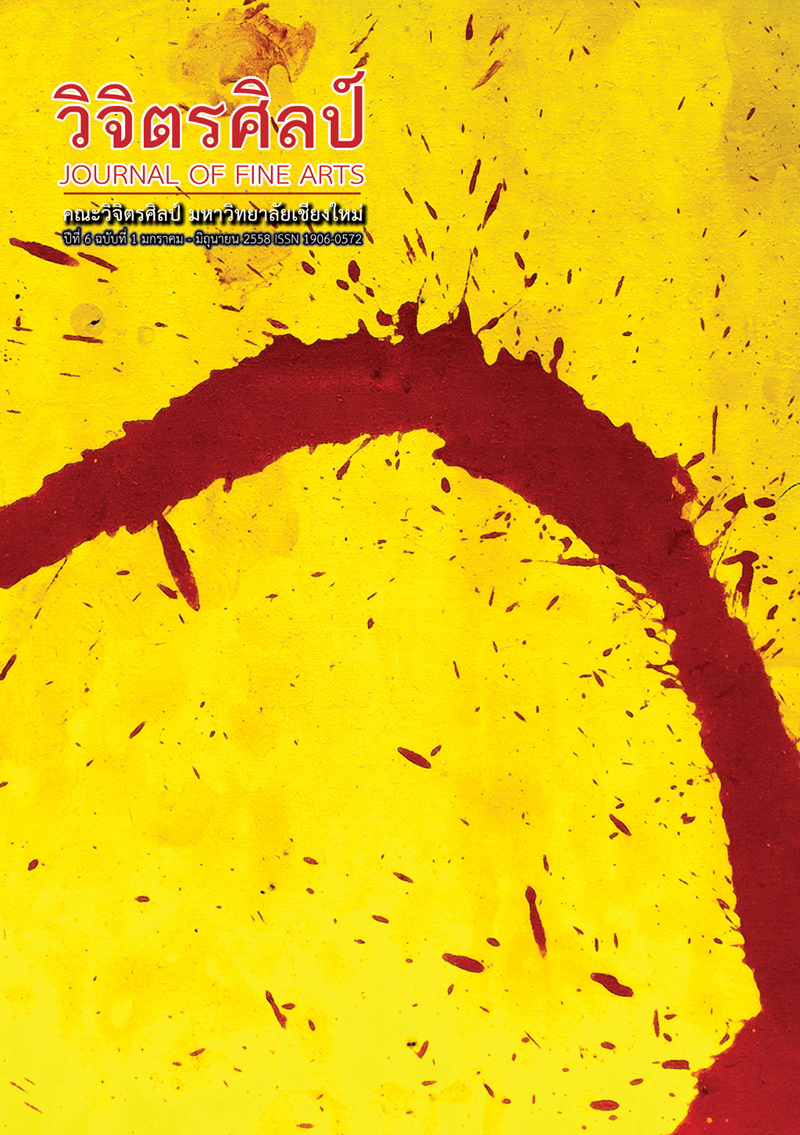พุทธลักษณะสกุลช่างครูบาโน รูปแบบ เทคนิค และแนวคิดการสร้างพระพุทธรูปครูเมืองละกอน
Main Article Content
Abstract
ผลการศึกษาพบว่างานพุทธศิลป์ครูบาโนตามบันทึกโบราณ ซึ่งมีจำนวน 63 แห่ง และได้ทำการสำรวจเพิ่มตามคำให้สัมภาษณ์ของคนในชุมชนใกล้เคียงอีก 7 แห่ง รวมสถานที่ที่ทำการเก็บข้อมูลคือ 70 แหล่งมรดกทางวัฒนธรรม ซึ่งพุทธลักษณะองค์พระทั้ง 70 องค์นั้นถือเป็นเอกลักษณ์ทางเทคนิคเชิงช่าง และเทคนิคการตกแต่งที่โดดเด่นซึ่งปรากฏในเขตนครลำปาง คือ อำเภอเมือง อำเภอเกาะคา อำเภอแม่ทะ อำเภอห้างฉัตร อำเภอเมืองปาน อำเภอแจ้ห่ม จังหวัดลำปาง และอำเภอแม่ใจ จังหวัดพะเยา อันเป็นเอกลักษณ์ของการสร้างพระพุทธรูปสกุลช่างครูบาโน หรือ ครูเมืองละกอน ทั้งนี้ข้อมูลดังกล่าวได้นำมาวิเคราะห์ตีความการเปลี่ยนแปลง ทั้งทางด้านคติความเชื่อ เทคนิคการตกแต่ง รวมถึงลักษณะอันเป็นเอกลักษณ์ของพระพุทธรูปในช่วงยุคสมัยที่ครูบาโนยังมีชีวิตอยู่ เช่น จิกโมฬี, ชายสังฆาฏิ, ติ่งพระกรรณ,และดอกบัวรองมือ ซึ่งองค์ความรู้ที่ได้นั้นสามารถนำไปใช้ในการสร้างและอนุรักษ์รวมถึงผลักดันให้เป็นมรดกทางวัฒนธรรมท้องถิ่นในอนาคต เพื่อใช้เป็นข้อมูลในการจัดทำพิพิธภัณฑ์งานศิลป์ครูบาโนของวัดปงสนุกเหนือต่อไป
Characteristics of Buddha Images in Kru Ba No Style: Forms, Techniques and Concepts of Original Muang Lakhon‘s Buddha Image.
The study of “Characteristics of Buddha Images in Kru Ba No Style: Forms, Techniques and Concepts of Original Muang Lakhon‘s Buddha Image” has the objectives to glean knowledge concerning the forms and characteristics of Buddhist Arts in Kru Ba No Style, and to study and analyze on the unique features of Buddhist art in Kru Ba No Style in terms of belief, decorative techniques and relationship among the communities. The attained knowledge can be applied to the creation and conservation of art objects in this style and the attempts to promote this style of art as a cultural heritage of the local area. This study is a qualitative research work that uses the field survey technique as the main scheme for collecting data from the locals. The survey consists of many data collection activities such as in-depth interview and focus group interview qualitatively research survey by a field study with people in community, individual and group interview. The proportion and details of Buddhist art are recorded and the drawings of the recorded art are made in order to compare all pieces of art together before analyzing them for the unique form and creation techniques.
The results show that the quantity of pieces of art in Kru Ba No Style indicated in ancient records is 63. In addition, there are 7 more pieces of art discovered from the exploration in accordance with the interviewed local people. Hence, the total number of the cultural heritages to be studied on is 70. The 70 Buddha images have unique features concerning the creation technique and decorative techniques. The Buddha images are found in many districts in Lampang province, namely, Mueang, KohKa, Mae Tha, Hang Chat, Muang Pan and Chae Hom districts, and Mae Chai district in Phayao Province. These Buddha images are created in Kru Ba No Style or KruMueangLakhon Style.Such information is analyzed in order to interpret the changes in the belief and decorative techniques including the unique characteristics of the Buddha images from the period in which the Kru Ba No was still alive. The changes can be seen in the top knot style, the earlobe style, and the style of lotuses underneath the hands of the Buddha images. This knowledge can be used for creating and conserving this style of art, and for promoting this art style as the cultural heritage of the local area. The knowledge attained from this study can also be used for establishing Kru Ba No’s Pieces of Art Museum at PongsanukNuer Temple in the future.


